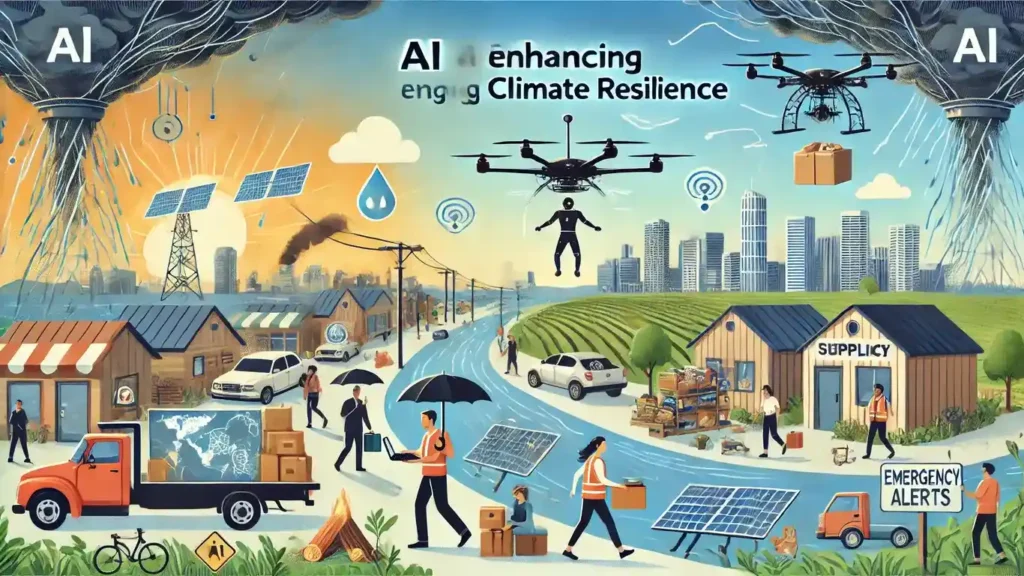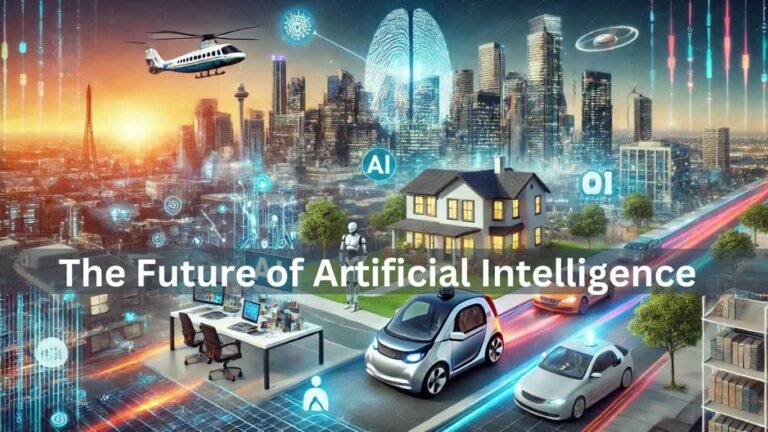Climate change is one of the most pressing issues of our time, affecting every corner of the globe. From rising sea levels to extreme weather events, the impact of climate change is undeniable. As the world grapples with this crisis, technology, particularly artificial intelligence (AI), is emerging as a powerful tool in the fight against climate change. This blog will explore the various ways AI is used to develop and implement solutions for climate change, demonstrating its potential to create a greener, more sustainable future.
Table of Contents
Understanding AI and AI in Climate Change
Before delving into how AI can help combat climate change, it’s important to understand what AI is and the basics of climate change. AI, or artificial intelligence, refers to the simulation of human intelligence in machines that are programmed to think and learn like humans. These intelligent systems can perform tasks that typically require human intelligence, such as visual perception, speech recognition, decision-making, and language translation.
Climate change, on the other hand, refers to long-term shifts and alterations in temperature and weather patterns, primarily due to human activities like burning fossil fuels, deforestation, and industrial processes. These activities increase the concentration of greenhouse gases in the atmosphere, leading to global warming and various environmental changes.
The intersection of AI and climate change lies in AI’s ability to analyze vast amounts of data, recognize patterns, and make predictions that can help mitigate the impact of climate change and develop adaptive strategies.
AI in Environmental Monitoring
One of the most significant applications of AI in combating climate change is environmental monitoring. AI-powered satellites and sensors are used to collect data on various environmental parameters such as deforestation, ice melt, and air quality. These technologies provide real-time data, allowing scientists and policymakers to monitor changes and make informed decisions.
For instance, AI algorithms can analyze satellite images to detect deforestation in real time, enabling authorities to take swift action against illegal logging. Similarly, AI can track the melting of polar ice caps, providing valuable insights into the rate of ice loss and its contribution to rising sea levels.
You may also visit: AI in Sports: Enhancing Performance and Fan Engagement
Moreover, AI-driven sensors can monitor air and water quality, detecting pollutants and providing early warnings of environmental hazards. By continuously collecting and analyzing data, AI helps scientists understand climate patterns and their effects on the environment, facilitating more effective climate action.
AI in Predicting Climate Patterns

Accurate predictions of climate patterns are crucial for preparing and responding to climate-related events. AI plays a vital role in climate modeling and forecasting by analyzing massive datasets and identifying trends that would be impossible for humans to detect manually.
AI algorithms can process data from various sources, including weather stations, satellites, and ocean buoys, to predict weather and climate trends. These predictions help governments and organizations plan for extreme weather events, such as hurricanes, floods, and droughts, reducing their impact on communities.
For example, AI can forecast the likelihood of a heatwave or heavy rainfall weeks in advance, giving authorities time to implement measures to protect vulnerable populations and infrastructure. Accurate predictions also support agricultural planning, ensuring that farmers can adapt to changing weather conditions and maintain crop yields.
AI in Reducing Carbon Emissions
Reducing carbon emissions is a critical component of combating climate change, and AI is playing a significant role in this effort. AI technologies are being used to optimize energy usage in various sectors, from buildings to transportation, ultimately reducing greenhouse gas emissions.
In buildings, AI can manage energy consumption more efficiently by adjusting heating, cooling, and lighting based on occupancy and weather conditions. Smart thermostats and energy management systems use AI algorithms to learn patterns and make real-time adjustments, leading to significant energy savings.
In the transportation sector, AI is used to optimize traffic flow, reducing congestion and emissions. AI-powered traffic management systems can analyze traffic patterns and adjust signal timings to minimize idle time and fuel consumption. Additionally, AI is being integrated into electric vehicles to enhance their efficiency and extend battery life.
You may also visit: AI in Finance: Predicting Market Trends and Improving Efficiency
AI also supports the development of renewable energy sources like solar and wind power. AI algorithms can predict energy production based on weather forecasts, allowing grid operators to balance supply and demand more effectively. This ensures a stable and reliable renewable energy supply, reducing reliance on fossil fuels.
AI in Sustainable Agriculture
Agriculture is another sector where AI is making significant strides in promoting sustainability and combating climate change. AI applications in precision farming are helping farmers optimize resource usage, reduce waste, and increase productivity.
Precision farming involves using AI and other technologies to monitor and manage crops at a micro-level. AI-powered drones and sensors can collect data on soil health, moisture levels, and crop growth, providing farmers with detailed insights into their fields. This information enables farmers to apply water, fertilizers, and pesticides more precisely, reducing waste and minimizing environmental impact.
For instance, AI can analyze soil data to determine the optimal amount of water needed for irrigation, preventing overwatering and conserving water resources. Similarly, AI can detect pest infestations early, allowing farmers to target treatments more effectively and reduce the use of harmful pesticides.
By improving the efficiency and sustainability of agricultural practices, AI helps reduce greenhouse gas emissions from farming and supports the resilience of food systems to climate change.
AI in Enhancing Climate Resilience

Building climate resilience is essential for communities to withstand and recover from the impacts of climate change. AI is playing a crucial role in enhancing climate resilience by supporting disaster response and recovery efforts.
AI can analyze data from various sources to predict and respond to natural disasters. For example, AI algorithms can process data from weather sensors, social media, and emergency services to predict the path and impact of a hurricane. This information allows authorities to issue timely warnings, evacuate residents, and deploy resources more effectively.
In the aftermath of a disaster, AI can assist in recovery efforts by analyzing satellite images to assess damage and identify areas in need of aid. AI-powered drones can conduct aerial surveys, providing real-time information on infrastructure damage and helping prioritize repair and reconstruction efforts.
Moreover, AI can help design climate-resilient infrastructure by simulating the impact of various climate scenarios. This enables engineers and planners to develop buildings, roads, and other structures that can withstand extreme weather events, reducing the vulnerability of communities to climate change.
Challenges and Ethical Considerations
While AI holds great promise in addressing climate change, it also presents challenges and ethical considerations that need to be addressed. One of the primary challenges is ensuring data privacy and security, as the widespread use of AI involves the collection and analysis of vast amounts of data.
Additionally, there is a digital divide that can limit the accessibility and effectiveness of AI solutions, particularly in developing countries. Ensuring that AI technologies are accessible to all and that they benefit communities equitably is crucial for their success in combating climate change.
Ethical considerations also include the need for transparency and accountability in AI applications. It is essential to ensure that AI systems are developed and used responsibly, with clear guidelines and regulations in place to prevent misuse.
You may also visit: Autonomous Vehicles: The Road to a Driverless Future
International cooperation and collaboration are vital in addressing these challenges and ensuring that AI is used effectively and ethically to combat climate change. By working together, governments, organizations, and communities can harness the power of AI to create a sustainable and resilient future.
Conclusion
AI has the potential to revolutionize the way we address climate change, from monitoring environmental changes and predicting climate patterns to reducing carbon emissions and enhancing climate resilience. By leveraging AI technologies, we can develop more effective and sustainable solutions to mitigate the impact of climate change and build a greener future for generations to come.
As we continue to explore and expand the applications of AI in climate change solutions, it is crucial to address the challenges and ethical considerations associated with its use. By doing so, we can ensure that AI serves as a powerful and responsible tool in our fight against climate change, benefiting communities worldwide and helping protect our planet.
We invite you to share your thoughts and ideas on the role of AI in climate change. How do you think AI can further contribute to environmental protection? Join the conversation and support AI-driven environmental projects to make a positive impact on our world. Together, we can create a more sustainable future.







